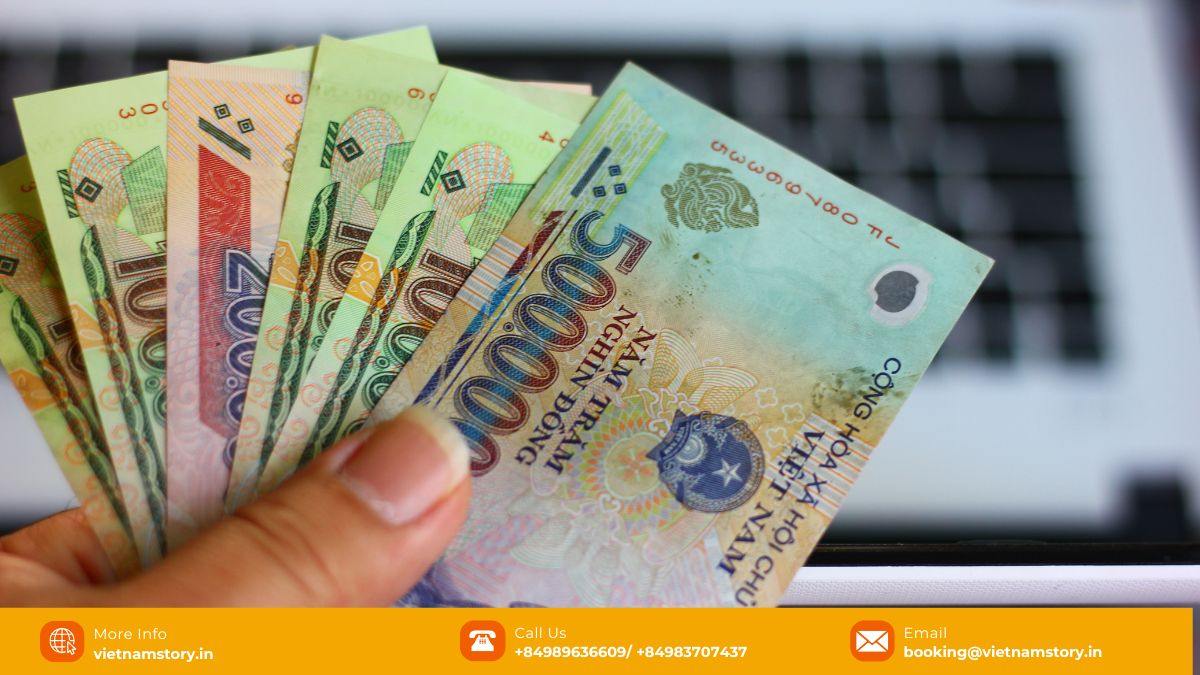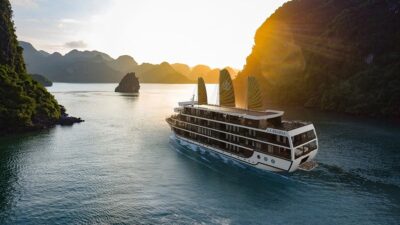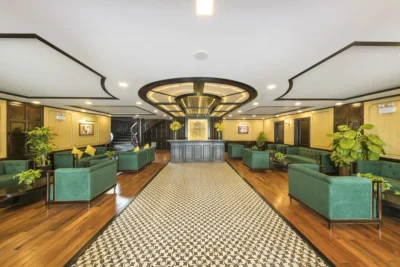Vietnam, a land of breathtaking landscapes and rich cultural heritage, promises an unforgettable journey for Indian travelers. The country has a young, tech-savvy, and mobile-first population that adopts new digital tools quickly, with mobile connections reaching 164% of the population in early 2023.
This guide gives Indian tourists a practical, up-to-date overview of Vietnam payment methods. You’ll see when to use cash, where cards work well, how locals pay with e-wallets and bank transfers, and what actually matters for your day-to-day spending on the ground.
Whether you’re planning everything independently or comparing curated India to Vietnam tour packages, understanding how payments work from day one will save you time, stress, and unnecessary fees.

Vietnam Payment Methods: Your Comprehensive Guide
Cash (Vietnamese Dong – VND): Still the Undisputed King
Despite the push toward cashless options, cash is still the most dominant and widely accepted payment method in Vietnam. This is especially true for daily expenses and outside the main tourist hubs. Even with a 169% rise in cashless transactions between 2020–2021, cash bounced back strongly as pandemic restrictions eased. In 2020, about 90% of Vietnamese preferred cash-on-delivery, the highest rate in Southeast Asia, mainly because of perceived security and habit. By 2021, cash still made up about 58% of Point-of-Sale (POS) transactions.
- Vietnamese Dong (VND): Get familiar with the main banknotes you will actually use: 10,000, 20,000, 50,000, 100,000, 200,000, and 500,000 VND. Coins exist but are almost never used. Pay extra attention to the 20,000 VND (blue polymer) and 500,000 VND (darker blue polymer) notes, as the colour and size can look similar in low light and lead to mistakes.
- Where cash is non-negotiable: Cash is essential in rural, remote, and underbanked areas. It is also the default for street food vendors, local markets, mom-and-pop shops, cyclos, and many taxis. Even some e-commerce orders are still paid by cash-on-delivery. Always keep enough cash with you, especially small notes, for these situations.
- Using cash safely and smartly: Keep your money in different pockets or a money belt. Avoid showing a large stack of bills in public. Double-check your change, especially when paying with 200,000 or 500,000 VND. Watch out for counterfeit notes or “wrong change” in very busy areas. Exchange money only at banks or reputable counters. A mix of 10k, 20k, and 50k notes is ideal for street food, short rides, and tips.
Where to exchange money
- Best options: Large Vietnamese banks, official exchange counters in cities, and licensed booths in central areas of Hanoi and Ho Chi Minh City.
- Avoid: Unofficial street exchangers, random small shops, or offers from strangers, even if the rate looks tempting.
- Tip: Exchange a small amount at the airport for initial expenses, then compare rates in town before changing larger amounts.
ATMs and cash withdrawals
- Where to find ATMs: You will see ATMs in airports, city centers, big malls, and outside bank branches. In smaller towns, ATMs are fewer, so withdraw in advance when possible.
- Limits: Many ATMs cap each withdrawal at around 8–10 million VND. If you need more, withdraw in several smaller transactions.
- Safety: Use ATMs attached to well-known banks or inside malls. Shield your PIN and keep your card in sight at all times.
Tipping in Vietnam
- Restaurants: A 5–10% tip is appreciated in mid-range and high-end places if service is good. Many local eateries do not expect tips.
- Guides and drivers: It is common to tip guides and drivers on multi-day tours. Small amounts in VND are fine and always appreciated.
- Hotels and services: Porters, spa staff, or housekeeping may receive a small tip for good service, but it is not mandatory.
READ MORE: A guide to currency, payments and tipping in Vietnam
Card Payments (Credit & Debit): Growing Acceptance in Urban Hubs
Card payments are becoming more common, especially in big cities and key tourist destinations. Part of this growth comes from government support for cashless payments and a pandemic-era shift in habits. The total value of card transactions rose by about 13.7% in 2021 after modest growth in 2020. By 2022, annual card spending in Vietnam reached roughly US$36.4 billion.
Credit and debit cards
Visa, Mastercard, and JCB are the main international cards accepted in Vietnam. You can rely on them more in mid-range to high-end hotels, larger restaurants, shopping malls, department stores, and certain tourist attractions, especially in Hanoi, Ho Chi Minh City, and Da Nang. However, overall card penetration in Vietnam is still relatively low, at about 1.29 debit cards and 0.08 credit cards per capita, so card acceptance is far from universal. Always ask first if cards are accepted before ordering or booking. Some places may add about a 3% surcharge on card payments to cover bank fees.
Where to use cards
Use your cards mainly in formal, established businesses in big cities. Do not assume your card will work in local eateries, small shops, or markets, even in touristy areas. Always carry cash as your backup. Before you travel, make sure your Indian card is enabled for international transactions and online payments in Vietnam.

Transaction fees and exchange rates
Be aware of international transaction fees from your Indian bank, usually around 1–3% per card payment. At some terminals, you might see an option to pay in INR instead of VND using dynamic currency conversion (DCC). This almost always comes with a worse exchange rate. In most cases, it is better to pay in VND and let your bank handle the conversion. Check your bank’s foreign transaction fees and ATM charges before your trip so there are no surprises.
Card security
Use ATMs linked to well-known banks, big branches, or shopping centers. Avoid isolated ATMs when possible. When using your card in a shop or restaurant, keep it in sight. For online payments such as hotel bookings or attraction tickets, make sure the website uses a secure connection (https) and looks reputable before you enter your card details.
Digital Wallets & Mobile Payments: Booming Locally, Tricky for Tourists
Digital wallets are exploding in popularity inside Vietnam. The country has a very smartphone-heavy population, with around 73.5% of adults owning a smartphone in 2022. Wallet penetration is expected to rise from 19.7% in 2020 to about 55.5% by 2025. According to Visa research, around 76% of Vietnamese consumers use mobile wallets in some form.
Popular local e-wallets
The digital wallet market is crowded, with over 40 providers competing. Some of the leading names include:
- MoMo – holds roughly 47% market share.
- Viettel Pay – around 25% market share.
- ZaloPay – about 17% market share.
- ShopeePay (formerly AirPay) – about 10% market share.
- Moca – integrated with the Grab app for rides, food delivery, and more.
Usage for tourists
You will see locals scanning QR codes and paying in seconds almost everywhere, from coffee chains to small shops. However, for a short-term Indian tourist, using these local wallets is usually not practical. Most apps require a Vietnamese phone number and a local bank account to sign up and top up. International wallets and UPI are not widely integrated into this system yet. So, enjoy watching how fast and convenient it looks, but do not depend on local e-wallets for your own day-to-day spending unless you are relocating or staying long term and can set up local banking.
Bank Transfers & QR Codes: A Backbone of Local Payments
Bank transfers are a major pillar of Vietnam’s payment system. They account for at least 29% of e-commerce revenue. This is supported by NAPAS (National Payment Corporation of Vietnam), which runs the core national retail payment network.
Mobile banking & NAPAS 24/7
Because smartphone usage is so high, mobile banking apps are extremely popular for sending money. The NAPAS 24/7 service allows instant transfers between accounts at different banks within seconds, any time of day. This is how many locals pay each other, pay bills, or settle group payments.
VietQR: The QR code revolution
Launched in 2021, VietQR is a unified QR code system that connects directly to bank accounts instead of wallets. Its growth has been dramatic. In the first half of 2023, QR code payments via VietQR grew by about 152% in transaction volume and 301% in total value, the fastest among all non-cash methods.
More than 50 banks are part of the network. As a tourist, you will notice VietQR codes printed at cashiers, on tables, or next to bills. For now, they are mainly used by locals, but regional projects are underway to connect such systems across countries like Thailand and Singapore, which could make cross-border QR payments easier in the future.
Buy Now, Pay Later (BNPL): Popular Locally, Irrelevant for Short Trips
BNPL services such as Atome, Fundiin, and Kredivo are gaining ground, especially with younger Vietnamese who shop online and may not have credit cards. These services let locals split payments into interest-free instalments, mostly for e-commerce, fashion, and electronics.
For overseas tourists on short holidays, BNPL is generally not relevant. You are unlikely to need or qualify for these services during a vacation.
READ MORE: Briefs about Vietnam visa for Indians
Navigating Payments in Different Settings
Knowing which payment method to use in each setting makes daily life in Vietnam much easier.
- Street food and local markets: Here, cash in VND is absolutely essential. Vendors usually cannot take cards or foreign currency. Bargaining is common at markets. Use small notes for snacks, drinks, and souvenirs.
- Restaurants and cafes: In larger, tourist-friendly restaurants and chain cafes in Hanoi, Ho Chi Minh City, and other big cities, you’ll often be able to pay with both cash and cards. Many smaller, family-run eateries remain cash only. Before ordering a large meal, it is wise to ask, “Credit card?” or show your card politely.
- Hotels and accommodations: International chains and good-standard hotels usually accept credit cards and sometimes bank transfers. Smaller homestays, guesthouses, and rural lodges may prefer or only take cash. Confirm payment options when you book, especially if you’re arriving late at night.
- Transportation: Most traditional taxis, local buses, and mini-vans still rely on cash. Ride-hailing apps such as Grab allow you to link a card in the app in some cases, but the cash option remains the simplest and most reliable for visitors. Always keep small notes ready for short rides.
Regional differences in payment habits
- Hanoi and Ho Chi Minh City: Cards and some digital options are common in malls, hotels, and chain restaurants, but cash is still important for daily life.
- Da Nang, Hoi An, Nha Trang: Tourist areas have broad card acceptance, yet street food, markets, and small shops remain cash-focused.
- Ninh Binh, Sapa, Mekong Delta and other rural areas: Cash is king. ATMs may be fewer, so plan your withdrawals in advance.
Essential Tips for Indian Tourists

- Inform your bank before travelling: Let your Indian bank know your travel dates and that you will be in Vietnam. This reduces the risk of your card being blocked for “suspicious activity” when you make your first overseas payment or ATM withdrawal.
- Carry a mix of payment methods: Never depend on only one option. Bring a combination of VND cash (different denominations), at least one debit card and one credit card, and keep some emergency funds accessible if needed.
- Check fees and exchange rates in advance: Review your bank’s foreign transaction fees, ATM withdrawal charges, and the exchange rate markup they apply. Avoid unnecessary currency swaps. Use banks or licensed exchange counters instead of random street booths. On card terminals, always choose to be charged in VND, not INR.
- Stay scam-aware: Count your change carefully, especially at busy spots. Check high-value notes for obvious defects or strange texture. Use ATMs inside banks, malls, or busy public areas and shield your PIN. Politely decline unsolicited “help” from strangers at ATMs or exchange counters.
- Confirm payment options early: Before you order food, jump into a taxi, or book an activity, ask which payment methods are accepted. A simple phrase like “Cash only, or card also?” avoids last-minute surprises.
- Keep small notes handy at all times: For taxis, street snacks, and small purchases, the most useful bills are 10,000, 20,000, and 50,000 VND. Many vendors struggle to change 500,000 VND, especially late at night or early in the morning.
Embracing Vietnam’s Payment Mix
Navigating different Vietnam payment methods becomes much easier once you understand the basic landscape. Vietnam is moving fast toward a digital-first future, backed by policies such as the National Digital Transformation Programme and a young population where around 77% have tried going cashless.
At the same time, cash in VND remains essential for Indian tourists, especially outside big cities and in everyday situations like street food, taxis, and markets.
- Carry a smart mix of cash and internationally enabled cards.
- Inform your bank before you fly.
- Confirm payment options whenever you are unsure.
By understanding how cash, cards, and local tools like MoMo and VietQR fit together, you can manage your money calmly and focus on what really matters.
That might be tasting your first bowl of phở in Hanoi, paying for a Halong Bay cruise, or settling the final bill on one of the curated Vietnam private tours that handle hotels, transfers, and activities for you. Your payment experience should quietly support your trip, not get in the way of your unforgettable Vietnamese adventure.












